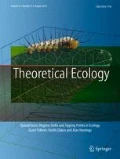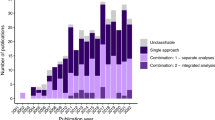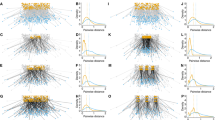Abstract
Migratory animals are comprised of a complex series of interconnected breeding and nonbreeding populations. Because individuals in any given population can arrive from a variety of sites the previous season, predicting how different populations will respond to environmental change can be challenging. In this study, we develop a population model composed of a network of breeding and wintering sites to show how habitat loss affects patterns of connectivity and species abundance. When the costs of migration are evenly distributed, habitat loss at a single site can increase the degree of connectivity (mixing) within the entire network, which then acts to buffer global populations from declines. However, the degree to which populations are buffered depends on where habitat loss occurs within the network: a site that has the potential to receive individuals from multiple populations in the opposite season will lead to smaller declines than a site that is more isolated. In other cases when there are equal costs of migration to two or more sites in the opposite season, habitat loss can result in some populations becoming segregated (disconnected) from the rest of the network. The geographic structure of the network can have a significant influence on relative population sizes of sites in the same season and can also affect the overall degree of mixing in the network, even when sites are of equal intrinsic quality. When a migratory network is widely spaced and migration costs are high, an equivalent habitat loss will lead to a larger decline in global population size than will occur in a network where the overall costs of migration are low. Our model provides an important foundation to test predictions related to habitat loss in real-world migratory networks and demonstrates that migratory networks will likely produce different dynamics from traditional metapopulations. Our results provide strong evidence that estimating population connectivity is a prerequisite for successfully predicting changes in migratory populations.





Similar content being viewed by others
References
Aebischer A, Perrin M, Krieg M, Studer J, Meyer DR (1996) The role of territory choice, mate choice and arrival date on breeding success in the Savi’s warbler Locustella lusciniodes. J Avian Biol 27:143–152. doi:10.2307/3677143
Alatalo RV, Lundberg A, Glynn C (1986) Female pied flycatchers choose territory quality and not male characteristics. Nature 323:152–153. doi:10.1038/323152a0
Alerstam T (1990) Bird migration. Cambridge University Press, Cambridge
Ardia DR (2005) Tree swallows trade off immune function and reproductive effort differently across their range. Ecology 86:2040–2046. doi:10.1890/04-1619
Berthold P (1998) Bird migration: genetic programs with high adaptability. Zoology 101:235–245
Berthold P, Pulido F (1994) Heritability of migratory activity in a natural bird population. Proc R Soc Lond B Biol Sci 257:311–315. doi:10.1098/rspb.1994.0131
Boulet M, Gibbs HL, Hobson KA (2006) Integrated analysis of genetic, stable-isotope and banding data reveals migratory connectivity and flyways of the yellow warbler (Dendroica petechia). Ornithol Monogr 61:29–78. doi:10.1642/0078-6594(2006)61[29:IAOGSI]2.0.CO;2
Brewer D, Diamond A, Woodsworth EJ, Collins BT, Dunn EH (2000) Canadian atlas of bird banding. Canadian Wildlife Service, Environment Canada, Ottawa
Chamberlain CP, Blum JD, Holmes RT, Feng X, Sherry TW, Graves GR (1997) The use of isotope tracers for identifying populations of migratory birds. Oecologia 109:132–141. doi:10.1007/s004420050067
Cramp S, Simmons KEL (eds) (1977) Handbook of the birds of Europe, the Middle East, and North Africa: the birds of the Western Palearctic. Oxford University Press, Oxford
Dolman PM, Sutherland WJ (1995) The response of bird populations to habitat loss. Ibis 137:S38–S46
Esler D (2000) Applying metapopulation theory to conservation on migratory birds. Conserv Biol 14:366–372. doi:10.1046/j.1523-1739.2000.98147.x
Gross JL (1999) Graph theory and its applications. CRC, Boca Raton
Hobson KA, Aubry Y, Wassenaar LI (2004) Migratory connectivity in Bicknell’s thrush: locating missing populations with hydrogen isotopes. Condor 106:905–909. doi:10.1650/7545
Hobson KA, Wassenaar LI (1997) Linking breeding and wintering grounds of Neotropical migrant songbirds using stable hydrogen isotopic analysis of feathers. Oecologia 109:142–148. doi:10.1007/s004420050068
Holmes RT, Sherry TW (2001) Thirty-year bird population trends in an unfragmented temperate deciduous forest: importance of habitat change. Auk 118:589–609. doi:10.1642/0004-8038(2001)118[0589:TYBPTI]2.0.CO;2
Jones J, Doran PJ, Holmes RT (2003) Climate and food synchronize regional forest bird abundances. Ecology 84:3024–3032. doi:10.1890/02-0639
Jones J, Doran PJ, Holmes RT (2007) Spatial scaling of avian population dynamics: population abundance, growth rate, and variability. Ecology 88:2505–2515. doi:10.1890/06-1514.1
Kelly JF, Ruegg KC, Smith TB (2005) Combining isotopic and genetic markers to identify breeding origins of migrant birds. Ecol Appl 15:1487–1494. doi:10.1890/04-1704
Marra PP, Norris DR, Haig SM, Webster MS, Royle JA (2006) Migratory connectivity. In: Crooks KR, Sanjayan M (eds) Connectivity conservation. Cambridge University Press, New York
Martin TM, Chades I, Arcese P, Marra PP, Possingham HP, Norris DR (2007) Optimal conservation of migratory birds. PLoS ONE 2:e751. doi:10.1371/journal.pone.0000751
Norris DR, Marra PP, Kyser TK, Royle JA, Bowen GJ, Ratcliffe LM (2006) Migratory connectivity of a widely distributed Neotropical–Nearctic migratory songbird. Ornithol Monogr 61:14–28
Norris DR, Taylor CM (2006) Predicting the consequences of carry-over effects on migratory populations. Biol Lett 2:148–151. doi:10.1098/rsbl.2005.0397
Part T (2001) The effects of territory quality on age-dependent reproductive performance in the northern wheatear, Oenanthe oenanthe. Anim Behav 62:379–388. doi:10.1006/anbe.2001.1754
Pulido F (2007) The genetics and evolution of avian migration. Bioscience 57:165–174. doi:10.1641/B570211
Pulido F, Berthold P, vanNoordwijk AJ (1996) Frequency of migrants and migratory activity are genetically correlated in a bird population: evolutionary implications. Proc Natl Acad Sci U S A 93:14642–14647. doi:10.1073/pnas.93.25.14642
Rubenstein DR, Chamberlain CP, Holmes RT, Ayres MP, Waldbauer JR, Graves GR, Tuross NC (2002) Linking breeding and wintering ranges of a migratory songbird using stable isotopes. Science 295:1062–1065. doi:10.1126/science.1067124
Slagsvold T, Lifjeld JT (1988) Ultimate adjustment of clutch size to parental feeding capacity in a passerine bird. Ecology 69:1918–1922. doi:10.2307/1941168
Sutherland WJ, Dolman PM (1994) Combining behaviour and population dynamics with applications for predicting consequences of habitat loss. Proc R Soc Lond B Biol Sci 255:133–138. doi:10.1098/rspb.1994.0019
Taylor CM, Norris DR (2007) Predicting conditions for migration: effects of density dependence and habitat quality. Biol Lett 3:280–283. doi:10.1098/rsbl.2007.0053
Urban DL, Minor ES, Treml EA, Schick RS (2009) Graph models of habitat mosaics. Ecol Lett 12:260–273. doi:10.1111/j.1461-0248.2008.01271.x
Van Horne B (1983) Density as a misleading indicator of habitat quality. J Wildl Manage 47:893–901. doi:10.2307/3808148
Webster MS, Marra PP, Haig SM, Bensch S, Holmes RT (2002) Links between worlds: unraveling migratory connectivity. Trends Ecol Evol 17:76–83. doi:10.1016/S0169-5347(01)02380-1
Wennerberg L (2001) Breeding origin and migration pattern of dunlin (Calidris alpina) revealed by mitochondrial DNA analysis. Mol Ecol 10:1111–1120. doi:10.1046/j.1365-294X.2001.01256.x
Winker K, Rappole JH, Ramos MA (1995) The use of movement data as an assay of habitat quality. Oecologia 101:211–216. doi:10.1007/BF00317286
Acknowledgements
CMT was supported by the National Science Foundation under grant no. 0434642 and DRN was supported by a Discovery Grant from the Natural Sciences and Engineering Research Council of Canada.
Author information
Authors and Affiliations
Corresponding author
Rights and permissions
About this article
Cite this article
Taylor, C.M., Norris, D.R. Population dynamics in migratory networks. Theor Ecol 3, 65–73 (2010). https://doi.org/10.1007/s12080-009-0054-4
Received:
Accepted:
Published:
Issue Date:
DOI: https://doi.org/10.1007/s12080-009-0054-4




